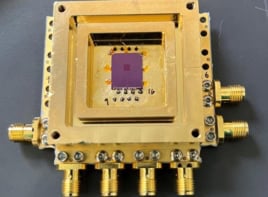
Physicists in Germany say they have found definitive evidence for the existence of superfluidity in an extremely cold 2D gas of fermions. Their experiment involved confining a few thousand lithium atoms inside a specially designed trap, and they say that the finding could help shed light on the role of reduced dimensionality in high-temperature superconductors.
Understanding the mechanisms that allow electrical current to flow without resistance inside cuprate materials at ambient pressure and at temperatures of up to 133 K is one of the biggest outstanding challenges in condensed-matter physics. Although scientists can explain the process behind more conventional, lower-temperature superconductivity, they are still trying to work out how the phenomenon can take place at high temperatures in what are essentially 2D materials (cuprates being made up of layers of copper oxide). Such low-dimensional materials are prone to fluctuations that prevent the long-range coherence thought to be essential for superconductivity.
2D Fermi gases can serve as model systems to try and help clear up this mystery, having strong and tuneable correlations between their constituent fermions that can mimic interactions in superconductors. Macroscopic quantum phenomena such as Bose–Einstein condensation involve large numbers of bosons – particles with integer spin – co-existing in a single quantum state. Fermions, in contrast, have half-integer spin and are subject to the Pauli exclusion principle – which precludes multiple particles sharing quantum states. But fermions can get around this restriction by pairing up and combining their spins.
Superfluidity too relies on a macroscopic quantum state of bosons, occurring at very low temperatures and causing the fluid in question to flow without viscosity. While 3D Fermi gases have previously been shown to exhibit superfluidity, only indirect evidence had been gleaned for the phenomenon in such gases restricted to 2D. But Lennart Sobirey and colleagues at the University of Hamburg have now observed superfluidity in a 2D Fermi gas thanks in part to a special kind of trap they initially demonstrated in 2017.
Box potential
The researchers carried out their experiment using a Fermi gas of about 6000 lithium-6 atoms. As is the case with 3D demonstrations, they first used a series of optical and magnetic techniques to cool the atoms down to a fraction of a degree above absolute zero and hold them in place. The difference this time was that they created what is known as a box potential, by loading the gas into an optical lattice created by two blue lasers. This tightly confined the gas to a very thin layer, with the energy needed to move atoms in the vertical direction exceeding the thermal energy and chemical potential of the gas.
To establish whether their gas was a superfluid, the team turned to the Landau criterion. This stipulates that excitations can only occur within a superfluid when there is movement above a certain minimum velocity. In other words, there will be no friction between the superfluid and any impurity that moves through it more slowly than this.
The impurity created by the researchers came in the form of a moving lattice of light. They directed two red laser beams at the centre of their trap, so creating an interference pattern with a sinusoidal potential. By offsetting the frequency of the two beams very slightly, they were able to move the lattice through the gas with a certain speed.
Temperature changes
They did this for a range of different velocities and in each case measured the system’s change in temperature – a measure of how many excitations were created. They found that as they increased the velocity the movement remained frictionless, until they reached a certain critical value. At this point the movement started to generate heat.
The researchers carried out this procedure both when the fermions interacted strongly to create a Bose–Einstein condensate and when they formed more weakly bound Cooper pairs. Although the precise response in the two states was different, in both cases they observed a critical velocity below which movement was frictionless. This, they say, “constitutes conclusive evidence of superfluidity”.

Superconductivity enters a new dimension
What’s more, the researchers found that this superfluidity was temperature dependent. By preparing the gas at different temperatures and in each case moving the lattice through the gas at a variety of speeds, they observed the critical velocity came into play at low temperatures but not at higher ones. In other words, the gas went through a phase transition from a superfluid to a normal fluid at a certain critical temperature. They determined that temperature to be 35 nK, which, they say, agrees very well with theoretical predictions.
John Thomas of North Carolina State University in the US, who was not involved with the research, points out that the experiments show a clear peak in the critical speed at the crossover from a Bose–Einstein condensate to a Fermi gas – where the gas is most strongly correlated. This, he says, “already provides new insights into the nature of superfluidity in 2D systems”. He adds that the work paves the way for studying the effects of dimensionality, which, he points out, can be smoothly tuned from 2D to 3D by reducing the strength of the confining potential.
The research is described in Science.



